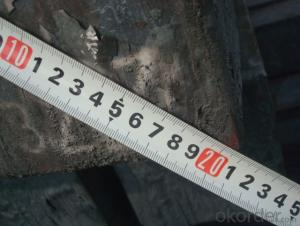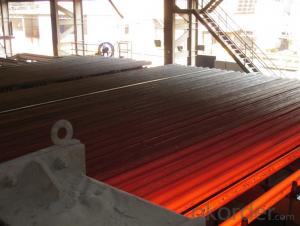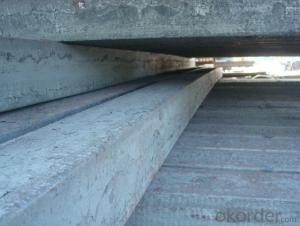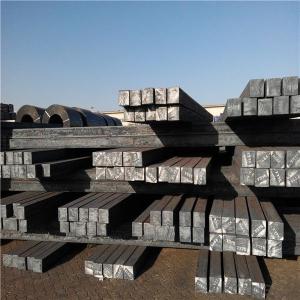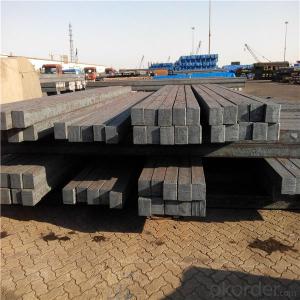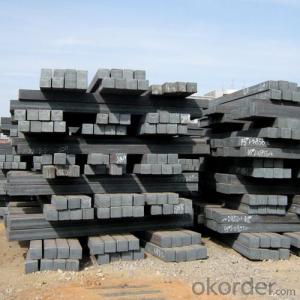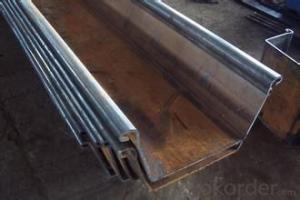2016 High Quality Low Price Steel Billet
- Loading Port:
- China main port
- Payment Terms:
- TT OR LC
- Min Order Qty:
- 25 m.t.
- Supply Capability:
- 1000000 m.t./month
OKorder Service Pledge
OKorder Financial Service
You Might Also Like
Quick Details
| Place of Origin: | China (Mainland) | Brand Name: | CNBM | Model Number: | 30*30-150*150 |
| Grade: | Q235,Q275 | Chemical Composition: | Hot Rolled Alloy Square Bar | Shape: | Square |
| Length: | 6m-12m | Standard: | ASTM | Technique: | Hot Rolled |
| Dimensions: | 100*100mm,130*130mm,150*150mm and etc | Alloy Or Not: | Is Alloy | Secondary Or Not: | Non-secondary |
| Product name: | 2016 High Quality Low Price Steel Billet |
Packaging & Delivery
| Packaging Details: | standard packing |
| Delivery Detail: | 7-30days |
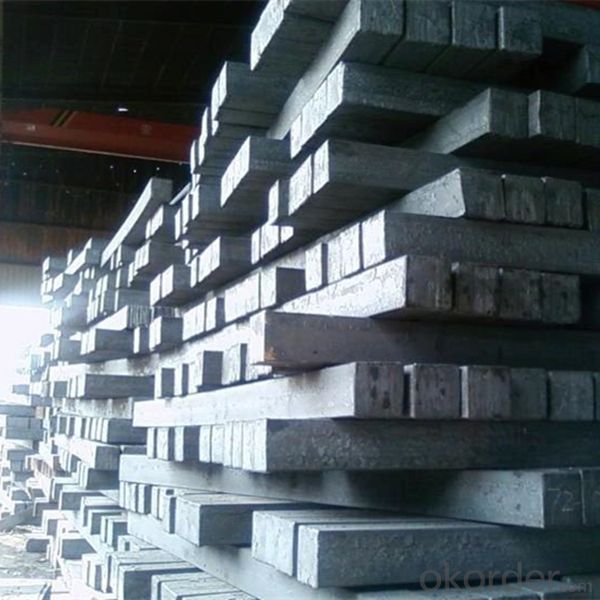
FAQ
FAQ:
1.What's your MOQ?
25MT, it is for one container.
2.Are the products tested before shipping?
Yes, all of our products was qualified before shipping. We test every batch every day.
3.What's your normal delivery time?
Our delivery time about 7-30days for standard sizes, if you have other requirements like hardness, quanity and width ,it is about 20-40days. But don't worry ,we also try our best for the delivery time ,because time longer and our cost is higher.
4.Do you send free sample?
Of cause.we send sample for free
Our Service:
1. Your inquiry related to our products or prices will be replied in 24hours.
2. Manufacturer with large capacity, ensure the fast production cycle after confirmed the order.
3. Our professional technicians will answer your entire enquiry in patient.
4. To meet the refractory solutions, we can serve as your instructions.
5. Protection of sales area and private information for our entire customer
- Q: How are steel billets used in the manufacturing of gears?
- Gears, which are mechanical devices that transmit power and motion, rely heavily on steel billets for their production. These billets, obtained through casting or rolling, are semi-finished steel products that serve as the foundation for gear manufacturing. To begin the process, the steel billets are heated to a specific temperature and then subjected to mechanical force, such as hammering or pressing, to shape them into the desired gear form. Once the initial shape is achieved, the billets undergo various machining operations, including milling, drilling, and grinding, to remove excess material and create precise dimensions and features. Steel billets offer numerous advantages in gear manufacturing. Their durability and strength allow them to handle heavy loads and high-speed rotations, while their excellent wear resistance ensures long-lasting performance. Additionally, steel billets can be easily machined to achieve intricate gear designs, enabling customization and optimization of gear performance. In conclusion, steel billets are indispensable in gear manufacturing as they provide the necessary strength, durability, and precision for gears to function effectively. Through forging and machining processes, these billets are transformed into gears capable of efficiently transmitting power and motion.
- Q: How do steel billets contribute to the manufacturing of machinery and equipment?
- Steel billets are a crucial raw material in the manufacturing of machinery and equipment. They serve as the starting point for various processes such as forging, rolling, and machining, where they are transformed into different components and parts. The high strength and durability of steel billets make them ideal for creating robust and reliable machinery, ensuring the final products can withstand heavy loads, harsh environments, and repetitive use. Additionally, the versatility of steel allows for the production of a wide range of machinery and equipment, from small tools to large industrial machinery, making it a vital component in the manufacturing industry.
- Q: How are steel billets used in the manufacturing of shipbuilding parts?
- The manufacturing of shipbuilding parts heavily relies on steel billets, which are vital in this process. These billets are essentially semi-finished steel products, usually in the form of rectangular or square bars, and are utilized as raw material for further processing in shipbuilding. To initiate the process, steel billets undergo rolling, where they pass through a series of rollers to decrease their cross-sectional area and increase their length. This rolling process converts the billets into elongated, slender sections of steel known as plates or sheets. These plates or sheets are then employed to fabricate diverse shipbuilding components, including hulls, decks, bulkheads, and superstructures. After the rolling process, the steel plates or sheets are cut into desired sizes and shapes using cutting machines or torches. These cut pieces are subsequently molded, bent, and welded together to form the necessary shipbuilding parts. For example, the steel plates can be bent and welded to create curved sections for the ship's hull, or they can be shaped into intricate forms for other components. Furthermore, steel billets are also utilized in the production of forged shipbuilding parts. In this scenario, the billets are heated to high temperatures and then subjected to intense pressure to reshape the steel. This forging process results in shipbuilding parts that are stronger and more durable, often used for critical components such as propeller shafts, crankshafts, and turbine blades. In conclusion, steel billets serve as the starting point in the manufacturing of shipbuilding parts. Through processes such as rolling, cutting, molding, and forging, these billets are transformed into plates, sheets, and forged components, all of which are crucial in constructing the various structural and functional elements of ships.
- Q: What are the main factors affecting the dimensional accuracy of steel billets?
- There are several main factors that can affect the dimensional accuracy of steel billets. Firstly, the temperature during the casting process plays a crucial role. Steel billets are typically cast at high temperatures, and any fluctuations or inconsistencies in the temperature can lead to dimensional inaccuracies. If the temperature is too high, the billet may expand and result in larger dimensions than desired. Conversely, if the temperature is too low, the billet may contract, leading to smaller dimensions than intended. Therefore, maintaining a consistent and controlled temperature is essential for achieving dimensional accuracy. Secondly, the cooling process after casting can also impact the dimensional accuracy of steel billets. Rapid cooling can cause the billet to contract unevenly, leading to distortions in its dimensions. On the other hand, slow cooling can result in excessive growth and expansion of the billet. Therefore, the cooling rate needs to be carefully controlled and optimized to ensure uniform and accurate dimensions. Thirdly, the design and condition of the casting molds can significantly influence the dimensional accuracy of steel billets. The mold should be properly designed to allow for shrinkage and compensate for any potential distortions. Additionally, the condition of the mold, such as wear and tear or improper alignment, can also lead to dimensional inaccuracies. Regular maintenance and inspection of the molds are necessary to ensure their proper functioning and minimize any potential impact on dimensional accuracy. Lastly, the composition and quality of the steel itself can affect the dimensional accuracy of the billets. Variations in the chemical composition or impurities in the steel can lead to inconsistencies in the cooling and solidification process, resulting in dimensional inaccuracies. Therefore, stringent quality control measures and precise composition monitoring are essential to minimize any variations in the steel and maintain dimensional accuracy. In conclusion, the main factors affecting the dimensional accuracy of steel billets include temperature control during casting, the cooling process, the design and condition of the casting molds, and the composition and quality of the steel. By closely monitoring and controlling these factors, manufacturers can ensure the production of steel billets with accurate dimensions.
- Q: What are the main factors that affect the competitiveness of steel billets manufacturers?
- There are several factors that significantly affect the competitiveness of steel billets manufacturers. These factors can determine the success or failure of a manufacturer in the highly competitive steel industry. 1. Cost of raw materials: The cost and availability of raw materials, such as iron ore and coal, play a crucial role in determining the competitiveness of steel billets manufacturers. Fluctuations in the prices of these raw materials can impact the overall production costs, and manufacturers need to ensure they have a reliable and cost-effective source of raw materials. 2. Production efficiency: The efficiency of the manufacturing process is another key factor. Manufacturers need to have streamlined production processes and advanced technology to maximize output while minimizing costs. Improving production efficiency can help manufacturers achieve economies of scale, which in turn can enhance competitiveness. 3. Quality control: The quality of steel billets is of utmost importance, as it determines the performance and durability of the final products made from these billets. Manufacturers need to implement stringent quality control measures to ensure that their products meet the required industry standards. Consistently producing high-quality steel billets can give manufacturers a competitive edge. 4. Technological advancements: Keeping up with technological advancements is crucial for manufacturers to stay competitive. Investing in advanced machinery, automation, and digitalization can improve production efficiency, reduce costs, and enhance product quality. Manufacturers need to adopt new technologies and continuously innovate to stay ahead of their competitors. 5. Energy costs: Energy-intensive processes are involved in steel billets manufacturing, and the cost of energy can significantly impact the competitiveness of manufacturers. Access to affordable and reliable energy sources is essential for manufacturers to maintain competitive prices. 6. Market demand and competition: The overall demand for steel billets and the level of competition in the market are significant factors affecting competitiveness. Manufacturers need to have a deep understanding of market trends, customer preferences, and emerging applications to align their production accordingly. Additionally, they must develop a strong marketing strategy to effectively compete with other manufacturers in the industry. 7. Access to skilled labor: The availability of skilled labor is crucial for manufacturers to maintain competitiveness. Skilled workers with expertise in steel production processes can contribute to improved efficiency and quality. Manufacturers need to invest in training programs and attract and retain skilled workers to stay competitive. 8. Government regulations and policies: Government regulations related to environmental compliance, labor laws, and trade policies can impact the competitiveness of steel billets manufacturers. Compliance with these regulations can add to the costs and administrative burden for manufacturers. Adapting to changing regulations and staying in line with industry standards is essential to maintain competitiveness. In conclusion, the competitiveness of steel billets manufacturers is influenced by various factors, including raw material costs, production efficiency, quality control, technological advancements, energy costs, market demand and competition, access to skilled labor, and government regulations. Manufacturers need to address these factors strategically to stay competitive in the ever-evolving steel industry.
- Q: How do steel billets contribute to the manufacturing of consumer electronics?
- Steel billets are an essential component in the manufacturing of consumer electronics due to their versatile properties and durability. These billets are essentially semi-finished steel products that are hot-rolled into various shapes and sizes, making them suitable for a wide range of applications. One of the main ways steel billets contribute to the manufacturing of consumer electronics is through the production of casings and structural components. Steel is known for its strength and rigidity, which makes it ideal for providing structural support and protection to electronic devices. Whether it is mobile phones, laptops, or gaming consoles, steel billets are used to create the outer casings that safeguard the internal components from damage. Additionally, steel billets are also utilized in the production of connectors and terminals found in consumer electronics. These small but crucial parts enable the flow of electricity between different components and ensure the smooth functioning of electronic devices. Steel's excellent electrical conductivity and resistance to corrosion make it a reliable material for these connectors, ensuring optimal performance and longevity of the electronic devices. Furthermore, steel billets contribute to the manufacturing of consumer electronics by being used in the fabrication of heat sinks. Heat sinks are essential in electronic devices to dissipate excess heat generated by the components, preventing overheating and potential damage. Steel's thermal conductivity and heat resistance properties make it an ideal material for these heat sinks, effectively transferring heat away from critical components and ensuring the reliability and longevity of the electronic devices. In conclusion, steel billets play a significant role in the manufacturing of consumer electronics by providing the necessary strength, durability, and thermal conductivity required for various applications. Whether it is in the production of casings, connectors, or heat sinks, steel billets contribute to the overall quality and functionality of electronic devices, ensuring a seamless user experience.
- Q: How are steel billets used in the production of construction machinery?
- Steel billets are a crucial component in the production of construction machinery. These billets, which are essentially semi-finished steel products, are shaped into various forms and sizes to create the necessary components of construction machinery. Once the steel billets are obtained, they are heated and then passed through a series of rolling mills to shape them into the desired forms. This process, known as hot rolling, allows the billets to be transformed into different profiles such as beams, channels, and angles, which are commonly used in the construction of machinery. The shaped steel components made from these billets are then further processed and fabricated to create the various parts of construction machinery. These parts can include the base frames, chassis, booms, arms, buckets, and other structural components. The use of steel billets in the production of construction machinery offers several advantages. Steel is known for its high strength, durability, and resistance to wear and tear, making it an ideal material for heavy-duty machinery. Additionally, steel can withstand extreme weather conditions and heavy loads, ensuring the longevity and reliability of the construction machinery. Moreover, steel billets are versatile and allow for customization to meet the specific requirements of different construction machinery. By using steel billets, manufacturers can produce machinery that is tailored to the needs of different construction projects, ensuring optimal performance and efficiency. In summary, steel billets play a vital role in the production of construction machinery. Through the process of hot rolling, these billets are transformed into various profiles that serve as the building blocks for creating the components of construction machinery. The use of steel billets ensures the strength, durability, and customization necessary for the demanding requirements of construction machinery.
- Q: Are steel billets used in the production of construction equipment?
- Yes, steel billets are commonly used in the production of construction equipment. Steel billets serve as the raw material for various components and parts of construction equipment, such as frames, chassis, brackets, and support structures. The high strength and durability of steel make it a preferred choice in the construction industry, ensuring the equipment's ability to withstand heavy loads and harsh working conditions.
- Q: What are the potential applications of steel billets in the mining aftermarket?
- Steel billets have a wide range of potential applications in the mining aftermarket. One of the key uses of steel billets is in the manufacturing of heavy machinery and equipment used in mining operations. These include components like gears, shafts, and cylinders, which require high strength and durability to withstand the harsh conditions of mining activities. Steel billets can also be used in the production of wear-resistant parts, such as cutting edges, buckets, and liners for mining equipment. These parts are subject to intense wear and tear, and the use of steel billets ensures their longevity and reliability. Furthermore, steel billets can be utilized in the construction of mine support structures, such as beams, columns, and frames. These structures provide stability and safety to mining operations, and steel billets offer the necessary strength and load-bearing capacity for their construction. In addition to equipment and structures, steel billets can be employed in the production of tools and accessories used in mining activities. For example, drill bits, hammers, and chisels require high strength and toughness to effectively break through hard rock formations, and steel billets provide the ideal material for their fabrication. Overall, the potential applications of steel billets in the mining aftermarket are vast and encompass various aspects of mining operations. From heavy machinery and equipment manufacturing to wear-resistant parts production and mine support structures, steel billets offer the necessary strength, durability, and reliability required to optimize mining processes.
- Q: What are the different surface defects found in alloy steel billets?
- There are several different surface defects that can be found in alloy steel billets. These defects can occur during the production process and can have an impact on the quality and performance of the final product. Some of the common surface defects found in alloy steel billets include: 1. Scale: Scale is a thin layer of oxide that forms on the surface of the billet during the heating and cooling process. It can be caused by exposure to air or by the presence of impurities in the steel. Scale can negatively affect the surface finish and can also lead to corrosion. 2. Cracks: Cracks can occur on the surface of the billet due to various reasons such as improper cooling, excessive stress, or improper handling. These cracks can weaken the structural integrity of the billet and can lead to failure during subsequent processing or in the final product. 3. Pits: Pits are small depressions or cavities that can be found on the surface of the billet. They can be caused by the presence of impurities or by the reaction of the steel with the environment. Pits can affect the surface finish and can also act as stress concentration points, leading to further damage or failure. 4. Laminations: Laminations are layers or sheets of non-metallic material that can be found within the billet. They can occur due to incomplete bonding during the production process or due to the presence of impurities in the steel. Laminations can weaken the billet and can lead to failure under load. 5. Inclusions: Inclusions are non-metallic particles or impurities that can be found within the steel. They can be introduced during the production process or can be present in the raw materials. Inclusions can affect the mechanical properties of the steel and can lead to reduced strength, toughness, and ductility. 6. Decarburization: Decarburization is the loss of carbon from the surface of the steel. It can occur during the heating process or due to exposure to air. Decarburization can result in reduced hardness and strength in the affected area. It is important to detect and address these surface defects in alloy steel billets to ensure the production of high-quality and reliable products. Various inspection and testing methods, such as visual inspection, ultrasonic testing, and magnetic particle inspection, can be employed to identify and assess these defects.
Send your message to us
2016 High Quality Low Price Steel Billet
- Loading Port:
- China main port
- Payment Terms:
- TT OR LC
- Min Order Qty:
- 25 m.t.
- Supply Capability:
- 1000000 m.t./month
OKorder Service Pledge
OKorder Financial Service
Similar products
Hot products
Hot Searches
Related keywords










